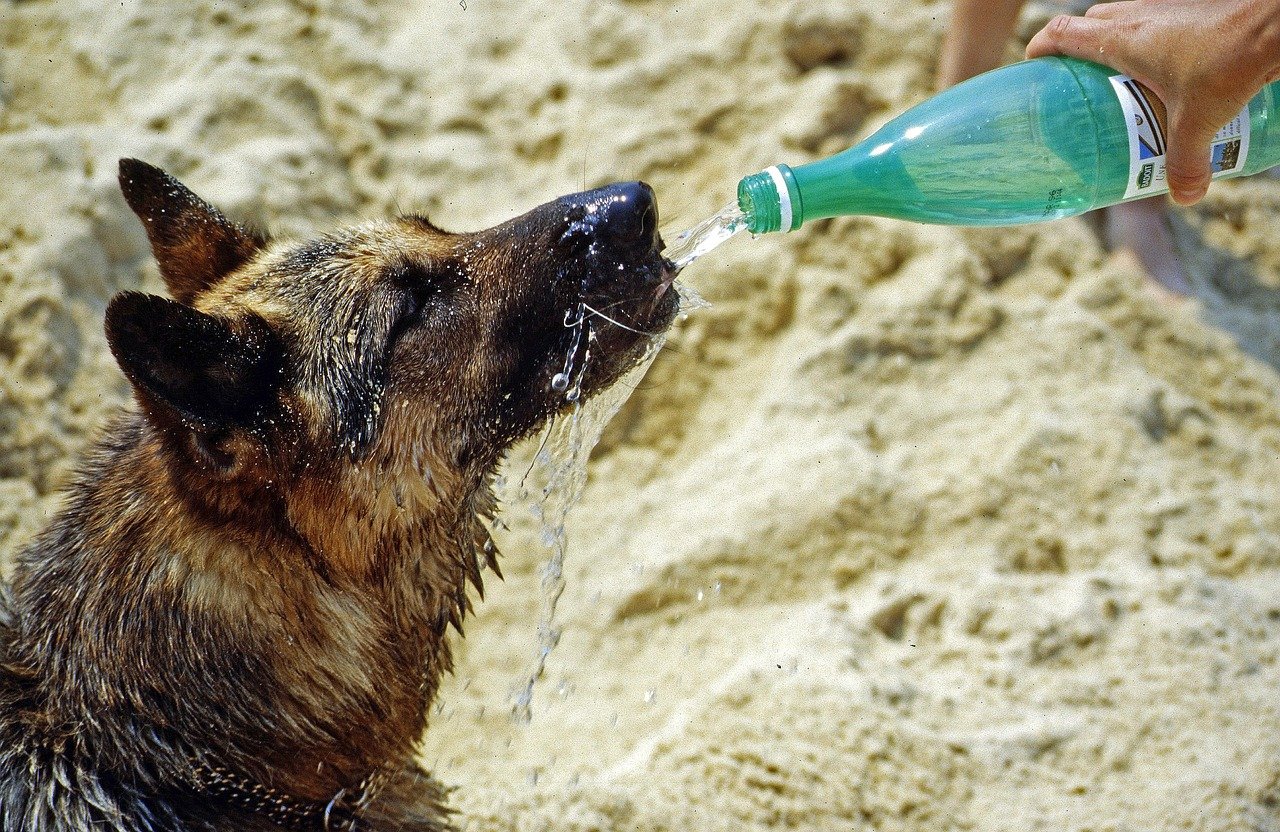Arizona’s desert climate has always been challenging for pets, but with temperatures consistently breaking records, dogs across the state are facing unprecedented risks of heatstroke. The combination of extreme heat, changing weather patterns, and an increasing number of vulnerable dog breeds has created a perfect storm that’s putting more canine lives at stake than ever before. This isn’t just about hot weather anymore – it’s about survival. Unlike humans, dogs can’t sweat to cool themselves—they rely on panting, which quickly becomes ineffective in scorching triple-digit temperatures. Breeds with short snouts, like bulldogs and pugs, are especially at risk, as their airways make heat regulation even harder. Even a short walk on sizzling pavement can push a dog’s body temperature into dangerous territory within minutes. Vets across Arizona are reporting spikes in emergency cases every summer, with many preventable tragedies. For pet owners, awareness and quick action can mean the difference between life and death when the desert sun is at its fiercest.
The Desert Reality: Understanding Arizona’s Heat Challenge

Living in Arizona means dealing with temperatures that can literally kill your dog. Where temperatures can often exceed 110°F, the asphalt on Arizona’s Valley streets can reach up to 160-170 degrees Fahrenheit during the summer months, and with temperatures regularly reaching 115° in Phoenix, it’s no wonder pavement burn is a real danger. The state’s dry desert air might feel less oppressive than humid climates, but it’s actually more dangerous for dogs who rely on panting to cool down.
The opening summer heat spike set Phoenix records on Tuesday and Wednesday, with five deaths attributed to the heat in the Valley, and for your animals, this kind of heat can be just as, if not more, dangerous. What makes Arizona particularly treacherous is how quickly temperatures can spike and how long they stay elevated, leaving little reprieve for dogs who need cooler periods to recover from heat stress.
Vulnerable Breeds: Who’s Most at Risk

Most of the breeds at higher risk of heatstroke are brachycephalic (flat-faced), and brachycephalic dogs had twice the odds of suffering heatstroke than dogs with an average muzzle like labradors. These flat-faced companions include bulldogs, pugs, Boston terriers, and French bulldogs – breeds that have become incredibly popular in Arizona despite being poorly suited for the climate.
Some breeds are particularly vulnerable to the heat, with brachycephalic breeds such as bulldogs, pugs, Boston terriers, and shih tzus having shorter nasal passages that make it more difficult to pant effectively, putting them at higher risk for overheating. Brachycephalic breeds are approximately 90% more likely to suffer from heat stroke than other dog breeds. The anatomy that makes these dogs so adorable – their squished faces and shortened airways – becomes a deadly liability when temperatures soar.
Climate Change: The Growing Threat

Arizona’s heat isn’t just getting worse – it’s becoming unpredictable and more intense. This study used data from 2016, and temperature records have since been broken, with the intensity and frequency of heatwaves predicted to increase in the future. Climate scientists are warning that what we consider extreme temperatures today will become the new normal, making heat safety for dogs not just a seasonal concern, but a year-round necessity.
The changing climate patterns mean that traditional “safe” times for dog activities are shrinking. Early mornings that once provided relief are staying warmer longer, and evening cooldowns are happening later, if at all. This compression of safe outdoor time is forcing dog owners to completely rethink their pets’ daily routines and exercise schedules.
The Science Behind Canine Heat Stress

Unlike humans, dogs only have sweat glands on their paws and must rely on panting to cool down, with the normal body temperature for a dog between 100.5 and 102.5 degrees Fahrenheit, and heatstroke results when the dog cannot regulate their body temperature, and it rises to 104-105 degrees Fahrenheit or higher. This biological limitation makes dogs inherently vulnerable in hot climates like Arizona’s.
According to Cornell University’s Canine Health Center, dogs begin to experience heatstroke when their internal temperature reaches 105 degrees or higher, and if elevated body temperatures are prolonged, they will cause damage to every organ in the body, with heatstroke commonly leading to acute kidney injury, blood clotting issues and shock. The cascade of organ failure that follows makes heatstroke a true medical emergency that can kill within hours.
Warning Signs Every Arizona Dog Owner Must Know

Early signs of heatstroke include heavy panting and rapid breathing, excessive drooling, dry mucous membranes, bright red gums and tongue, skin that’s hot to the touch, and a higher heart rate, with affected dogs becoming hyperactive and having difficulty maintaining balance. These symptoms can escalate rapidly, so recognizing them early could save your dog’s life.
The most telling symptom of heat stroke in dogs is excessive panting, with other symptoms including signs of discomfort such as drooling, reddened gums, vomiting, diarrhea, mental dullness or loss of consciousness, uncoordinated movement, and collapse, as heat stroke in dogs can indicate a serious medical problem and cause unseen problems, such as swelling of the brain, kidney failure, intestinal bleeding and abnormal clotting of blood. Don’t wait for multiple symptoms – even one concerning sign should prompt immediate action.
Emergency Response: What to Do When Seconds Count

If you suspect your dog may be experiencing heatstroke, call your veterinarian or local emergency veterinary hospital immediately, as your vet will instruct you on beginning to cool your dog prior to arrival at the hospital, which is extremely important because cooling your pet prior to arrival at the hospital has been shown to increase their chances of survival from 50% to 80%. The golden rule is “cool first, transport second” – but you must do both.
Cool water (not cold) may be poured over the head, stomach, armpits and feet, but do not cover the dog with wet cloths as this can prevent evaporative or radiative cooling, though you can mist cool water over the dog and place them in the path of a fan or air conditioning to promote cooling, with ice packs and rubbing alcohol no longer recommended as a method to promote temperature reduction. Every second counts, and proper cooling technique can mean the difference between life and death.
The Pavement Problem: Arizona’s Hidden Danger

The asphalt on Arizona’s Valley streets can reach up to 180 degrees Fahrenheit during the summer months, with temperatures regularly reaching 115° in Phoenix making pavement burn a real danger, and once outside temperatures surpass 95°, the risk of pavement burn increases for bare skin contact, including our pets’ paws. This isn’t just uncomfortable – it’s capable of causing third-degree burns within seconds.
One of the most frequent questions from dog parents is how to determine if it’s too hot for a walk, with a simple and reliable test being the pavement test: Place the back of your hand on the pavement for seven seconds – if it’s too hot for your hand, it’s definitely too hot for your dog’s paws. Pavement temperatures can reach up to 125°F, which is far too hot for your pet’s sensitive paws. This simple test could prevent painful, expensive, and potentially crippling injuries.
Legal Realities and Public Policy Changes

Phoenix Trails are closed to all dogs when temperatures reach 100° and above because of the risk of heat stroke and pavement burn, with the Phoenix Parks and Recreation Department and the Parks Board adopting this policy to protect your dog’s health and safety on high temperature days, and violators could be subject to a Class One Misdemeanor that could include a fine of up to $2,500 and six months jail time. These aren’t suggestions – they’re legally enforceable protections that recognize the genuine danger heat poses to dogs.
Under Arizona law, it is considered animal cruelty if a person intentionally, knowingly or recklessly leaves an animal unattended and confined in a motor vehicle where physical injury to or death of the animal is likely to result, and if you are found guilty, you will face a class 1 misdemeanor which is the most serious misdemeanor, with a class 1 conviction leading to three years of probation, a $2,500 fine and a maximum of six months in jail. The state is taking heat-related animal welfare seriously, and ignorance is no longer an acceptable excuse.
Professional Treatment: What Happens at the Emergency Vet

Treatment of heatstroke in dogs includes hospitalization for the affected pup, with further treatment typically including IV fluids to treat dehydration, medication such as Cerenia, famotidine, sucralfate to reduce or prevent symptoms of vomiting and diarrhea, and antibiotics as part of the treatment to prevent infection. The complexity of treatment shows why heatstroke isn’t something you can handle at home – it requires intensive veterinary care.
Recovering from heatstroke is directly related to how high the dog’s temperature was, for how long, and how quickly they arrived at the hospital, with major damage occurring when the body’s temperature reaches higher than 109°F, and while most dogs that survive the initial 24 hours will live, they remain hospitalized on IV fluids and supportive care for two to three days, though once discharged, they typically can make a full recovery and go on to live normal lives. The good news is that with prompt treatment, most dogs do survive – but the experience is traumatic and expensive for everyone involved.
Prevention Strategies for Arizona Dog Owners

Time of day matters, so aim for walks in the early morning or late evening when surfaces have cooled, with outdoor temperatures under 75°F generally safe for most dogs, but caution advised between 75–85°F, especially for dogs with thick coats or short snouts, and it’s suggested to walk your dog before 9 a.m. or after 6 p.m.. This narrow window of safe outdoor time requires Arizona dog owners to be much more strategic about their pets’ exercise than owners in milder climates.
Prevention is the best way to avoid heatstroke, so always ensure your dog has access to a bowl with fresh, cool water, provide a shady spot outside for your pup, and consider setting up a fan for them. Never leave your dog in a car unattended, avoid strenuous exercise in hot and humid weather, provide access to shade while outside, offer frequent opportunities to drink water, avoid walks during the hottest time of the day, and remain indoors during periods of extreme heat and humidity.
The Economic Impact of Canine Heatstroke

Over 20,000 sick, injured, and abused pets are taken care of each year at the Arizona Humane Society, with the organization especially overrun during hot summer months, as their field teams go on thousands of calls every year, and about a third of the calls from pets in distress are about the heat. This massive strain on animal welfare resources shows the scale of the heat-related crisis facing Arizona’s dogs.
On Tuesday alone, the society’s emergency animal medical technicians responded to 55 calls for help, with more than half for heat-related ailments. The emergency veterinary costs for treating heatstroke can easily reach thousands of dollars, not including the emotional toll on families who watch their beloved pets suffer. Prevention isn’t just about animal welfare – it’s about avoiding devastating financial and emotional costs.
Conclusion: A Call for Awareness and Action

Arizona’s extreme heat isn’t just a challenge for dogs – it’s become an existential threat that demands immediate attention from every dog owner in the state. With climate change making temperatures more severe and unpredictable, and with vulnerable flat-faced breeds becoming increasingly popular, the risk of canine heatstroke is only going to grow. The science is clear: dogs are biologically ill-equipped to handle Arizona’s heat, and their lives depend on our understanding and vigilance.
The good news is that heatstroke is entirely preventable with the right knowledge and preparation. By understanding your dog’s risk factors, recognizing the warning signs, knowing how to respond in an emergency, and most importantly, taking proactive steps to keep your pet cool and safe, you can enjoy life in the desert without putting your furry family member at risk. Remember, your dog trusts you to make the smart decisions they can’t make for themselves.
What surprised you most about the hidden dangers Arizona heat poses to our four-legged companions?

Hi, I’m Andrew, and I come from India. Experienced content specialist with a passion for writing. My forte includes health and wellness, Travel, Animals, and Nature. A nature nomad, I am obsessed with mountains and love high-altitude trekking. I have been on several Himalayan treks in India including the Everest Base Camp in Nepal, a profound experience.



